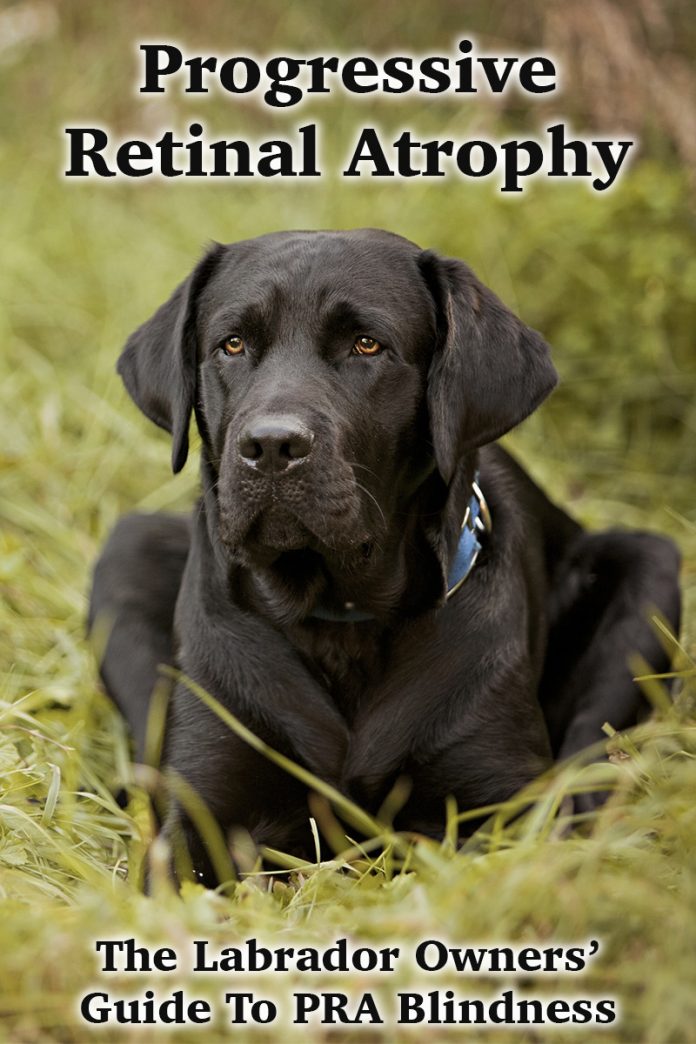Progressive Retinal Atrophy in dogs is commonly known by the abbreviation PRA. It is an important condition to be aware of if you are thinking of buying a Labrador puppy, or have a dog from parents who weren’t health tested. In this article we are going to take an in-depth look at PRA in dogs, helping you to understand what it is and what you can do to protect your Labrador.
What Is PRA?
PRA is the term used to described a collection of diseases that degenerate the lining at the back of the eye, known as the retina. This lining absorbs, reflects and processes light. Progressive Retinal Atrophy diseases result in the retina slowly failing to function at all, leading to blindness.
PRA comes in different forms, and the age that the dog’s eyes are affected and rate of progress of the disease will vary between them. Dogs with Progressive Retinal Atrophy will lose their sight anywhere between a year and eight years old.
Your Dog’s Eye
Your dog’s retina contains photoreceptor cells called rods and cones, that are responsible for turning the light that enters the eye into chemical energy. Rod cells control monochromatic vision and night vision. Cone cells deal with color vision. Dogs have far greater numbers of rods than cones, hence their poor color differentiation.
The type of Progressive Retinal Atrophy we see most commonly in Labrador Retrievers is prcd or ‘progressive rod-cone degeneration’. In most common forms of PRA it is the rod cells that are impacted by the disease, which gives them a mutation that causes them to die. This mutation can happen early in the dogs life, usually leading to blindness by the first birthday, or develops later on at around three to five years old.
Once the rod cells have died, too much oxygen is brought into the eyes for the remaining cone cells to cope with. They in turn become damaged and die as well.
Gradual vision reduction
The retina gradually becomes atrophied, giving less and less vision. In some rarer forms of PRA the action is a little different, with the pigmented epithelium coating of the retina losing it’s ability to process light.
Progressive Retinal Atrophy affects both of the dogs’ eyes. Although this process sounds nasty, it doesn’t cause the dog any pain at all. And the slow alteration in their vision means that dogs with PRA blindness tend to learn to cope pretty well. In fact the progression of PRA is so slow that most owners will not realise that their dog is effected until the eyes form cataracts..
Signs Of Blindness In Dogs
There are numerous signs of blindness in dogs. Including those clear to their owners such as a cloudy appearance to the eye, to more subtle signs like changes in behavior.
Progressive Retinal Atrophy Symptoms
Dogs with PRA blindness will show a fairly specific selection of symptoms, due to the slowly progressing nature of the diseases.
Early symptoms of Progressive Retinal Atrophy include:
- Poor vision in dim light
- Reluctance to go outside in the dark
- Confused behavior when the lights are dimmed
- Bumping into things at night
- Dilated pupils
- Pupils responding slowly to light
- A green shine to the eyes
Later Progressive Retinal Atrophy symptoms include:
- Development of cataracts – an opaque white circle in the centre of the pupil.
- Bumping into familiar things
- Trouble navigating stairs
- Full blindness
- Glaucoma
When it follows it’s usual projected pattern, PRA causes full blindness within a year of the symptoms first occuring.
PRA Diagnosis
PRA can often be confirmed by a veterinarian through a simple visual examination using an ophthalmoscope. They will look for signs of problems with the blood vessels in the retina, optic nerve and tapetum.
In dogs with secondary cataracts or for a confirmed later stage diagnosis, a veterinarian will need to use an electroretinogram, that records electrical impulses to confirm the diagnosis. This needs to be carried out under general anaesthetic, and involves putting an electrode onto the dog’s cornea and next to the eye. It can also be diagnosed before any symptoms are showing using a DNA test.
PRA Testing
We have had a diagnostic test of sorts available to us for over twenty years now, in the form of an annual eye examination for dogs. This important test helped to reduce the spread of the inherited disease. But it only gave limited information to the veterinarian, as it only showed them whether the dog was displaying symptoms at the time of the test.
It did not show whether they would develop the disease later on in life. This is where the fairly recently arrival of DNA testing comes into play.
PRA testing is possible as this disease has been linked to a particular faulty gene. PRA in Labradors is recessive, which means that you need to have the gene passed from both parents for your puppy to be affected. Every dog will inherit two copies of the gene, one from each parent. If both copies are healthy, the dog can never develop this form of blindness and cannot pass the disease onto its offspring.
Not a sure thing
Not all dogs who have a faulty gene passed on to them will develop the disease. Many will simply be carriers. If one parent is clear and the other is a carrier, then your puppy may be a carrier too. Carriers won’t go on to develop the disease.
However it is interesting to note that one study showed that although carriers do not display blindness as caused by PRA, they do still show some signs when their retinas are studied. With a general reduction in photoreceptor density as well as some areas of the retina with no rod cells. They won’t however go blind as a result of this.
Optigen PRA Test
The Optigen test for Labradors allows us to know whether an individual is clear, a carrier or affected. It helps us to make good choices about which dogs to breed from, and which other dogs to breed them with.
From a DNA sample the Optigen test can specifically determine whether or not the dog being tested has two healthy copies of the gene, two faulty copies or one of each. If he has two healthy copies he is designated as ‘clear’ of prcd-PRA. If he has two faulty copies he is designated ‘affected’ and if he has one of each he is a ‘carrier’.
The Optigen test is giving us a lot more information than the old eye exam. Especially it enables us to tell carriers and affected dogs apart, long before the affected dog’s eyes begin to deteriorate. And because it is a genetic test, it only needs to be done once.
In addition to this, puppies from two ‘clear’ parents need never be tested, as they cannot possibly inherit the faulty gene. However, perhaps the best thing about Optigen is that it allows us to breed from carriers, an act that some people find hard to understand initially.
Breeding From Carriers
Having the ability to breed for dogs which carry the faulty prod-pra gene is highly beneficial to the breed, because it maximises the gene pool. Within any breed of dogs that are contained within a closed gene pool, there is an increasing risk over time of new diseases appearing. And this risk reduces the gene pool ever further.
Each generation has its favourite stud dogs, and these tend to be used extensively on female dogs all over the country. Restricting matings to those between dogs who are also clear of prcd-PRA reduces the gene pool further still.
The last thing we should be doing is limiting our choice of breeding stock even further. Enabling matings to take place between clear dogs and carriers, give us a far greater choice of mates. Whilst ensuring that no puppies are born which will suffer from these diseases. Maintaining genetic diversity is crucial if we are to maintain the health of our pedigree dogs. And the Optigen test is another weapon in our arsenal in the battle against the disease.
Buying A Puppy From A Carrier
Provided that your puppy has one parent that is Optigen tested ‘clear’, then your puppy cannot ever develop this form of PRA. Even if the other parent is a carrier. It is therefore totally safe to purchase this puppy, provided that they have the other tests relevant to Labradors in place. Do not buy a puppy where one parent is a carrier and the other is untested, as if they are a carrier too then your puppy could develop the disease.
If your puppy puppy turns out to be a carrier, then just ensure that if you want to mate her you select a ‘clear’ stud dog.
PRA Prevention
PRA is predominantly an inherited disease. This means that your puppies genes will play a big part in whether or not he develops this disease.
The Optigen test is not a cure all, and there are other causes of blindness in Labradors. For this reason it is still a sensible precaution to buy puppies from breeders that also carry out the annual eye check. However, this relatively recent addition to the battery of tests that many Labrador owners now embark upon before breeding their dogs, offers long term benefits to the health of the breed.
It does so by eliminating affected dogs from our breeding stock before they show symptoms. And by enabling us to maximise genetic diversity through breeding from carriers where appropriate.
PRA Treatment
Sadly there is currently no cure for PRA. If your dog has been DNA tested as having two faulty genes, then he will develop PRA at some point in his life. However, although there is no cure it is possible that there may be a way to slow down the progression of the disease.
Anti-oxidants are being investigated for slowing the rate of damage. This is because they are hoped to protect the cone photoreceptors in your dogs retina from being damaged by the excess oxygen. However, as yet there are no clinical studies to confirm this conclusively.
Life With A Blind Labrador
Although it is very upsetting to know that your dog has or will develop PRA, there are lots of things you can do to help him adjust. Here are some good tips to follow to help your Labrador to stay happy and confident:
- Don’t move furniture
- Keep the floor clear
- Keep bowls in same place
- Put strips or mats in doorways to help the dog navigate
- Don’t suddenly touch them without warning, speak first so they know your hand is approaching
Progressive retinal atrophy is a slowly working disease. This does mean that the dog will lose their sight gradually, and have time to adjust to their new situation. With your help and support they will continue to have a happy and comfortable life.
References and Resources
- Zeiss, C. (et al), ‘Retinal Pathology of Canine X-Linked Progressive Retinal Atrophy, the Locus Homologue of RP3‘, Investigative Ophthalmology and Visual Science (1999)
The Labrador Site Founder
Pippa Mattinson is the best selling author of The Happy Puppy Handbook, the Labrador Handbook, Choosing The Perfect Puppy, and Total Recall.
She is also the founder of the Gundog Trust and the Dogsnet Online Training Program
Pippa's online training courses were launched in 2019 and you can find the latest course dates on the Dogsnet website



















Never mind! I just re-read the article and realized that we are in the clear with only one gene. Thanks!
We adopted an 8 year old Labrador last November who is completely blind. He’d been picked up as a stray and was never claimed by his family from the pound. I suspect he’s been blind a long time as he copes incredibly well. Before he came to us he spent a month in a foster home. He learned his way around their home and then immediately adapted to our home. He’s confident and so so cheerful and loves his 2 walks a day. He is toy mad and carries a cuddly toy on most walks. He uses his brain more than my other Labs have and is an impressive problem solver. Take heart if you have a recent diagnosis – life can still be great for a blind dog.
Thank you so much for sharing that Nicky – I’m sure it is a great comfort for those with a dog that has recently been diagnosed.
I went to the vet vision center today with my 3 year old lab. She has PRA and will be totally blind within a year. I cried all the way home. She is my side-kick, bed partner and best buddy. Her breed gave her away because she was not up to His Standards, hunt dog. I hope someone bites him where it hurts!!!
Hi Anna, I am so sorry to hear that. I know it doesn’t help right now, but many blind dogs lead happy, and fulfilling lives. Best wishes to you both. Pippa
I’m sorry to hear this; the same happened to me. But take heart: my PRA lab had a great life walking the neighborhood, even at night he knew when he was near the friendly treat-giving neighbor’s house. He still swam in the river – I would throw a stick, not too far, followed by a rock near to the stick, and he would find the stick. The vet specialist said that dogs have great mental-mapping skill. Just don’t move the furniture and do block off downward stairs. Life was pretty normal actually.
I am in tears reading this! My Lab Max that is 5 years of age has all of these symptoms, I am taking him to see the vet today. I rescued him 4 years ago from a shelter, he was born deaf and now this! Not sure how easy this road will be, we live in a double storey house and he is struggling with the stairs already. He is my baby and I am heartbroken!!! Please say a little prayer for Max today that the vet has some good news, no matter what happens I will never give up on him!!! 🙁
Hi Everyone, The past few months i’ve been noticing my 6 year old Lab Sandy is having trouble seeing at night. She has been walking right into things and has gotten hurt many times. When i looked at her eyes you could see a green color and they look like a glazing over them. Took her to the vet yesterday and they confirmed what i saw plus crystals in her eyes.At this point they want her to see a specialist . i’m heartbroken for my sweet girl. I will do whatever i have to help her . Does anyone know if there are vitamins or anything to help her. Thank you all for your stories, its a big help knowing were not alone. Thanks
Our “Rufus” was just diagnosed this week with PRA. We’d noticed his night blindness symptoms for a few months. Our regular vet couldn’t see anything wrong with his eyes, but with symptoms getting worse we took him to our local vet school clinic. The veterinary ophthalmologist said the disease was fairly progressed as his retinas appeared very thin already. They put him through an obstacle course which he aced. He doesn’t seemed blind at all in light conditions, but in dim light he’s bumping into stuff. The article said dogs usually go blind within a year of symptoms. We are praying this will not be the case with Rufus. He is extremely active on the farm. Runs wide open beside the ATVs and swims in the pond every day. I’d like to hear from anyone who’s tried the antioxidants.
My dog was just diagnosed with this at age 3. The vet suggested getting a puppy. I’m not sold on this idea. Does
Anyone have experience with this and was it beneficial?
Our girl was diagnosed with PRA when she was 4. We learned slowly with her. Bought balls with bells in. She would run along the beach, pick it up and bring it back when totally blind. She was ok going uphill or upstairs but anxious about going down. I taught her a Stop command. Tapped my food on the floor next to a treat. I would tap on the car so she knew how far and high to jump.
She was very brave, intelligent and special. She crossed Rainbow Bridge in our arms in March. She was nearly sixteen. It was a total privilege to share her life.
So glad to come across this article. We have been gradually going through the difficulty with the dark and steps. This lets me know more what to expect. It certainly has been challenging figuring out how to deal with things like getting her out at night. Comes down to get her out before dark. Not sure how it will work when it is dark longer. My girl Sugar is 11. Has had stem surgery for her hip dysplasia and arthritis. We can deal with this too.
I’m pleased to hear that you found the article useful. Best wishes to you and to Sugar.
I had no idea about any of this until November 2014. I came home from hospital with my new baby and noticed my beautiful tori’seye bulging (my Labrador) Straight to vet who immediately referred us to an ophthalmologist. I drove for 2 hours with her and she was diagnosed with glaucoma. Treated her with drops but it took hold and her eye was removed in march 2015. Started preventative drugs on remaining eye immediately. But despite all our efforts the glaucoma took hold. On 20th June 2016 we had the 2nd eye removed. Totally broken hearted but at least she’s still with me. She is 13 and fighting fit apart from this. I always feared arthritis but never this. She is finding her way around but getting very confused at times. It is now my turn to repay her for all the unconditional love and happiness she has given me over the years. I have cried solidly for a week. Is anybody further on in this journey? Does anybody have any useful tips or and experience of the “halo” that’s on the market?
This was very interesting, I wish I’d read about this 11 years ago. I didn’t know much about eye checks when we got our beautiful girl lab. As you described her vision got progressively poorer the older she became. We didn’t realize this straight away, I noticed she wasn’t as good at catching a ball or toy when she was very young, then noticed she occasionally bumped into things, initially thinking she was a bit clumsy or too quick, not slowing down enough so bumping into stuff. She was about 3 or 4 when we suspected it was due to her poor vision. She was a very loving dog and liked feeling we were nearby and close to her. We wanted to try to help her, so knowing removing her cataracts would help her sight for possibly up to 2 years, she went through cataract operations on both eyes when she was around 5 years old. This did initially work and gave her better sight for around a year to 18 months, we were delighted with this, she had more confidence initially but maybe it wasn’t worth her going through this operation, for the short time she benefited. She needed daily eye drops for the rest of her life after this lost her sight anyway. She developed glaucoma just before her journey to the rainbow bridge last summer aged almost 9. We still have two labs from a different breeder, one is still a puppy, only 8 months old. Thanks for sharing this.